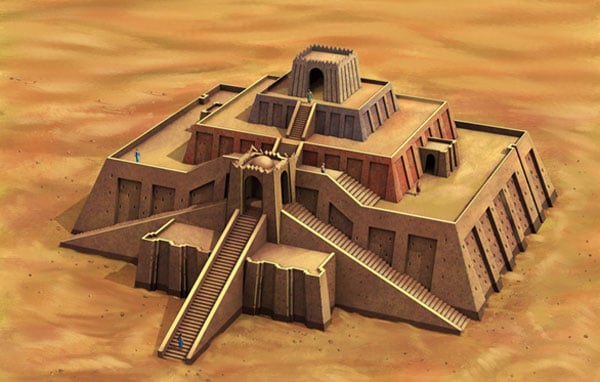Sumer and Akkad
 |
| Map shows early cities and city-state centered on Mesopotamia (between river Tigris-Euphrates) |
The only witness of the old powerful cities that grew up in Mesopotamia 5000 years ago today are dusty mounds that lie along with the flood lands of the Tigris and Euphrates. But these mounds allowed archeologists to collate the story of the first civilized peoples in the world.
The first farmers in the plain of Tigris-Euphrates were Sumerians with black hair, who learned to organize irrigation canals linked with the large rivers. The Sumerians were able to create a food surplus with irrigation. It was enough to support the full-time craftsmen and the local city god, or rather his deputy, the ruling prince, or Ensi, who acted both as the chief priest and governor of the house of God, lands, and servants. If an Ensi became sufficiently powerful to rule several cities, he took the title Lugal, meaning "king."
By 3000 B.C. The land of Sumer included a group of city-states, including Kish, Umma, and Lagash, whose hereditary leaders struggled for supremacy, until almost every city-state under its reign was united by Lugal Zaggis (approximately 2320 B.C.) from Umma. But Sargon (about 2306-2250 B.C.), ruler of Akkad, the region north of Sumer, overthrew this King. The dynastic kings of Akkad were Semitic, not Sumerian-speaking because a large part of the population had been Semites who entered Akkad. However, under the Akkadian rule, the Sumerian culture was blossoming.
As Sargon invaded Syria, the Akkadian state grew in size. He was able to get cedarwood in here. The Akkadians appreciated the fact that Mesopotamia lacked sufficient timber trees to make beams and doorways. Also to the north of Assyria and hilly Elam to the west of Sumer, Sargon won control. Trade increased in this enlarged state.
 |
| Mosaic depicting the royal feast proves Sumerians kept domesticated animals. |
Later the Akkadian King Naram Sin (approximately 2236-2189 B.C.) sent troops to Minor Asia. Yet his subject towns at home revolted and Akkadian rule grew weaker as time passed. It was succeeded in the time of Ur-Nammu by the mighty Sumerian kings of the third dynasty of Ur (about 2079-2061 B.C.).
 |
| The world's first trained troops resulted from Sumerian inter-city warfare. Pictured about 2900 b,c. These warriors from Lagash had tall shields and sphere with copper heads |
Sumer was seen at the height of his wealth in Ur's third dynasty. Foreign trade has freely spread and enriched Mesopotamia. And the Sumerians worshipped them as gods as the great Ur kings fell.
Religious beliefs played a significant role in Sumerian life. This led people to build impressive structures called "ziggurats" or "high places," which could have imitated the North Mountains of the Sumerians. Sumerians looked upon mountain peaks as god sanctuaries.
 |
| The Ur ziggurat as it looked about 2000 B.C, Millions of brick went into this man-made mountains. Hundreds of steps led to its temple summit- as high as a sixty- storey building. |
Although there was a lack of stone for the Sumerians, they learned to mix crushed reeds with river mud, shape the mixture into bricks, then let the bricks harden in sun. The solid city walls, the temple wall, and the foundation upon which the temple stood formed rocks at Ur. The brick-built ziggurat itself rose from that platform: a stepped tower roughly 75 feet high. However, the Sumerians were able to use bricks, which were possibly the first in history, for drains at doors and burial chairs of corbeled valleys and real arches.
Excavation of the royal burial vaults of the first Ur dynasty (about 2550 B.C.) uncovered some exciting findings: for example, the bodies of kings and their attendants, a silver model boat, gold pots, and many other artifacts testifying to Sumerian craftsmen's skills. The excavations have also shown that Sumerians probably made the world's first wheeled vehicles about 3500 B.C., and they were among the first people to invent writing. Their scripts tell us the hymns and prayers of priests, the transactions of merchants and the events in Sumeri- a story. We also found Sumerian seals on their belongings which stamped the names of the owners.
 |
| Sumerians wrote like this. Marks made on soft clay by their sharp reed style led to the invention of cuneiform (wedge-shaped) script. |
Even some of the first steps in mathematics and astronomy were taken in Sumerian civilization. Priests studied the seasonal cycle and developed a calendar that allowed farmers to tell them when to plant their crops. Sumerians based their numeral system on the number 60 rather than on hundreds. We owe our 60 minute hour and the 360-degree circle to them.
 |
| Diagrams show four stages in the development of Middle Eastern script, from picture symbols of about 3500 B.C. to cuneiform (700 B.C.) |
The story of Sumer merges into that of Babylonia * with the end of the third Ur dynasty about 1970 B.C. But now we're going to turn to another of the early civilization centers in the world — The Indus Valley.

ConversionConversion EmoticonEmoticon